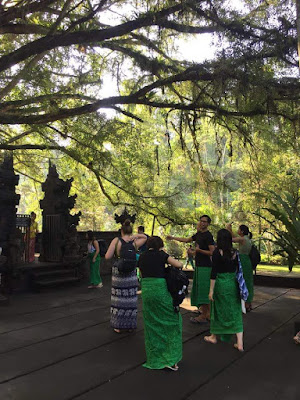Tirta Empul Temple
Tirta empul located in the village of Manukaya , Tampaksiring subdistrict and Gianyar Regency, it is about 39 KM east side of Denpasar town.
Pura tirta Empul is an important temple complex and holy
mountain spring, the site serves as a legendary setting of a traditional tale
about good versus evil. It is also a national cultural heritage site. The
complex, built circa 960, is also a silent witness to the old Balinese kingdom
years, particularly at the time of the Warmadewa Dynasty another nearby and prominent site on
top of a hill is the presidential palace, Istana Tampaksiring, built during the
years of the first president, Soekarno.
Tirta empul meaning ‘holy water spring’ is actually the name of a
water source located within the temple,in side the Temple complex has 3 key
division namely front,secondary, and inner courtyard.
First come you will see
gardens and pathways adorned statue and tropical plant, that lead to its
entrance, it is always important to dress respectfully. The simple Balinese
temple visitor dress code is a traditional ‘kamen’ wrap around the lower body
plus a sash around the waist.
Women during their periods are prohibited entry to any
temple or sacred site, and may enjoy the sights and attractions in the outer perimeters
only. You might want to consult your guide who may ask a temple authority for
further details,after that keep walking and stepping through this typical 'candi bentar' (temple
gate), second courtyard welcomes visitors to the bathing pools. There is a large 'wantilan' meeting hall stands at
the right side .
Inside the central courtyard, referred to as ‘madya
mandala’ or ‘jaba tengah’, pilgrims first approach a rectangular purification
bath where a total of 13 elaborately sculpted spouts that line the edge from
west to east. After solemn prayers at an altar-like shrine, they proceed to
enter the crystal-clear, cold mountain water. With hands pressed together, they
bow under the gushing water of the first spout, carrying on to the eleventh.
The water from the last two of the 13 spouts is meant for purification purposes
in funerary rites. The myth behind the curative and purifying spring tells of a
Balinese ruler, known by the title Mayadenawa, who is depicted to have defied
the influence of Hinduism and denied his subjects religious prayers and
practices. The legend goes that this eventually angered the gods, and in a
campaign, god Indra sought Mayadenawa’s subdual. Tirta Empul Temple Highlights
The hide-and-seek tactics of Mayadenawa fleeing Indra’s troops took place at
various places all over the region, from the rivers Petanu to Pakerisan, and up
to the north of Tampaksiring.
Hence, the names of
the sites and natural features all reflect an episode from the tale, such as
Tampaksiring - tampak meaning 'feet', and siring meaning 'sideways', depicting
an episode when the fleeing king left his footprints up the hill. It was here
that through his magical powers Mayadenawa created a poisoned spring from which
Indra’s exhausted troops drank and succumbed. Indra noticed the fall of his
men, and soon thrust his staff into the ground where a holy purifying spring
spurted out, to cure the troops and to even bring some of them back to life.
This escapade became the legendary background to the holy spring of Tirta
Empul, as well as the holy days of Galungan and Kuningan celebrated by the
Balinese Hindus.
Far at the front of the temple complex is a large parking area with its eastern side lined with art markets and rows of shops selling various curios and souvenirs. There are also several warungs or food stalls selling local food, snacks and refreshments.








0 komentar: